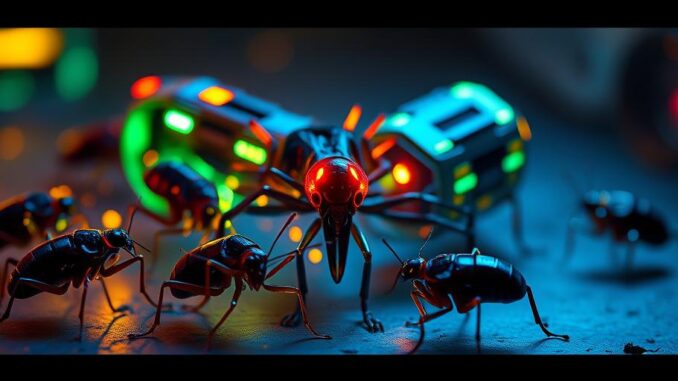
Summary
Researchers have developed cyborg cockroaches that navigate using UV light, eliminating the need for wires or surgery. This technology utilizes the cockroaches’ natural aversion to UV light to guide their movement, offering a less invasive and more sustainable approach to controlling insect cyborgs. The cyborg cockroaches successfully navigated mazes, showcasing their potential for search-and-rescue missions and other applications.
TrueNAS by Esdebe: healthcare data storage that delivers value without sacrificing security.
** Main Story**
Okay, so check this out: researchers have managed to create these crazy ‘cyborg cockroaches’ that they can steer without wires, surgery, or, get this, even electrical shocks! It’s pretty wild, right? Instead, they’re using a tiny UV light helmet to guide them, which takes advantage of the cockroach’s natural dislike for bright light, especially UV. The best part? It doesn’t mess with their senses, and they can control them consistently for longer periods, so it’s a win-win.
How the Light Steering Works
Think of it like this: imagine a cockroach wearing a tiny rave helmet and a backpack. The backpack has a wireless sensor. Now, if the cockroach stops moving, the backpack knows. If it stays still for too long, bam, the UV light kicks in. To steer, they shine the light in either the left or right eye. Seriously, it’s like some kind of weird insect Uber system. This clever system means they don’t overstimulate the roach and save battery, making the whole thing more efficient and sustainable. Pretty neat, huh?
Why It’s Better Than Zapping Them
Before this, controlling insects involved some seriously invasive stuff. We’re talking about surgery to implant electrodes, which can damage their sensory organs and stress them out. Plus, the electrical shocks can lose their effectiveness over time as the insects get used to them. But, on the other hand, with this light-based system, it uses their natural behavior. Which, I think, makes it a way more humane and effective way of doing things. I mean, who wants to be shocked all the time?
Testing the Roach-bots
They’ve put these cyborg cockroaches through the wringer and they’ve performed great, they respond every time and didn’t get used to it. Even better, in maze environments, these cockroaches navigated and escaped far better than regular cockroaches. But what exactly are these cyborg cockroaches for? Glad you asked, potential uses include:
- Search and Rescue: Picture this: after an earthquake, these little guys could crawl through rubble to find survivors, in spaces humans can’t reach.
- Environmental Monitoring: They could be equipped with sensors to measure temperature, humidity, or pollution levels in hard-to-reach areas.
- Tight Space Surveillance: The cockroaches can access and inspect very tiny spaces larger robots or even people would find difficult to reach.
These are just a few uses of the robots, however, and I am sure many more are being dreamed up in robotics labs all over the world.
AI in Healthcare: Bigger Picture
This cockroach thing isn’t just a cool science project; it’s part of a larger trend of AI being used in medicine and healthcare. Now, artificial intelligence is changing everything! Think about it – from better diagnoses to more efficient drug development.
To go over this in more detail, here are just a few areas were AI are making huge leaps:
- Spotting Diseases Early: AI can look at medical images and patient data to catch diseases like cancer way earlier than ever before.
- Customized Treatment: AI can also create a treatment plan specific to patients, taking into account their medical history and genetics for optimal results.
- New Drug Creation: AI can help discover drug targets and find molecules leading to new therapies.
- Resource Use: AI can predict patient needs and optimize hospital bed use, meaning resources are not wasted.
The Future of Healthcare with AI
All in all, AI has the potential to revolutionize healthcare. As AI keeps advancing, expect even more innovations that completely change how we practice medicine and deliver healthcare services. I think it is important to remember that this is just one example of how AI can improve our lives. Remember, this is all based on what we know today, May 27, 2025. The AI field? It’s changing every single day!


Be the first to comment